
The Apple Tree opened on Wednesday, 27th April 1955 and closed March 2014.
Crawley Observer, 29th April 1955Black Dog, Northgate
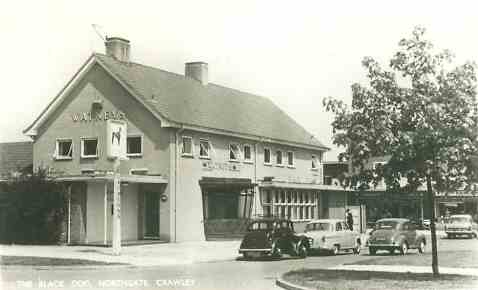
The Black Dog was the first of the New Town pubs, opening on Tuesday 26th April 1955 by Watney Coombe Reid & Co. The pub closed in 2016 and was converted into a restaurant and bar, opening in April 2017.
Crawley Observer, 29th April 1955Bluebird, Tilgate Park
See the Inn in the Park.
Brewery Shades, The HogsheadGrade II Listed (1948)
George Chantler is listed as a brewer between 1873 and 1877 at the Brewery Shades. Renamed The Hogshead for a short time during the late 1990's.
Herbert Hother (1938); A.E.W. Parker (1951); Brickwood Ales (1968)The Brewers of West Sussex, Peter Holtham, Sussex Industrial History No. 34
G.C. Butcher
G.C. Butcher is listed as a brewer at an unknown location in 1875.
The Brewers of West Sussex, Peter Holtham, Sussex Industrial History No. 34Chantler and Holder - New Town, Ifield
Chantler & Holder are listed as a brewer in 1869 and Henry Holder is listed as a brewer in 1889.
The Brewers of West Sussex, Peter Holtham, Sussex Industrial History No. 34Charcoal Burner, Furnace Green
The Charcoal Burner opened on Thursday, 6th July 1967.
Crawley Observer, 14th July 1967; 8th July 1987The Coaching Halt, Balcombe Road, Maidenbower

The Coaching Halt opened in November 2013.
Crown Inn - 61 Ifield Road, West Green
Originally a cottage selling beer.
In September 2009 a three month closure order was the subject of an appeal by the landlord, allowing the pub to stay open in the interim. However, following a serious public disorder incident at the pub on 12th December 2009 the police successfully gained an immediate 28 day closure order from Crawley Magistrates. At the end of January 2010 the pubs owners, Enterprise Inns, put the pub up for sale, and in 2011 it became a food shop.
Doctor Samuel Johnson, Langley Green
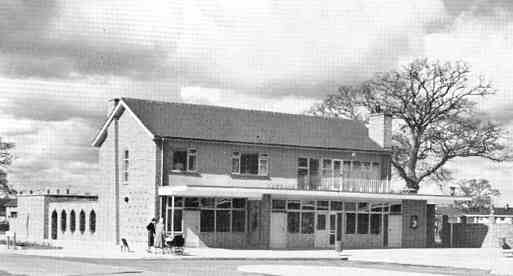
The Doctor Samuel Johnson opened on Monday, 12th November 1956 by Barclay Perkins & Co.
Crawley Observer, 16th November 1956Dorsten, Bewbush
The Dorsten closed at the beginning of January 2009 and was demolished in March to make way for the "Heart of Bewbush Regeneration" project.
Downsman, Southgate
The Downsman opened between 1st-6th April 1961 by Truman, Hanbury Buxton & Co.
Crawley Observer, 7th April 1961Flight Tavern, Lowfield Heath
Previously a private club, the Flight Tavern opened in 1986 and closed in 2011.
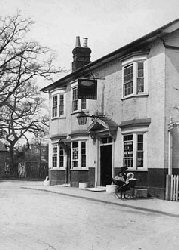
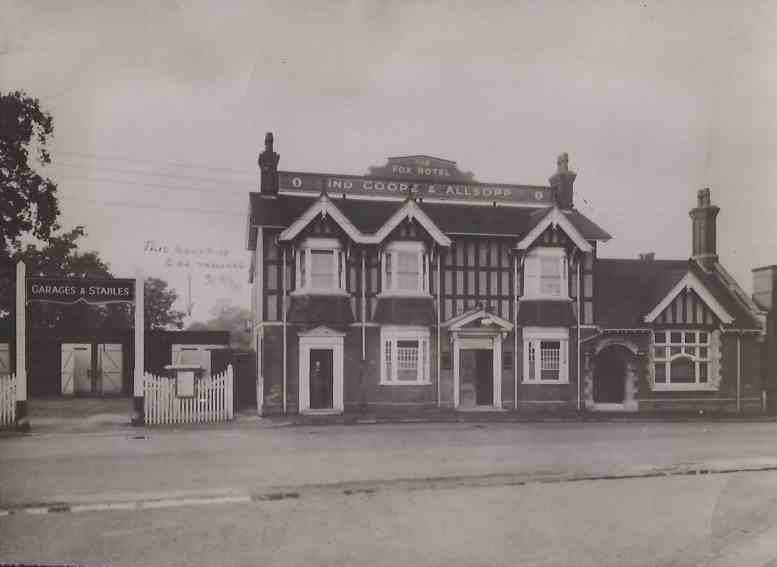
Frogshole FarmGrade II Listed (1983)
Gate Inn
The George, High Street, CrawleyGrade II* Listed (1948)
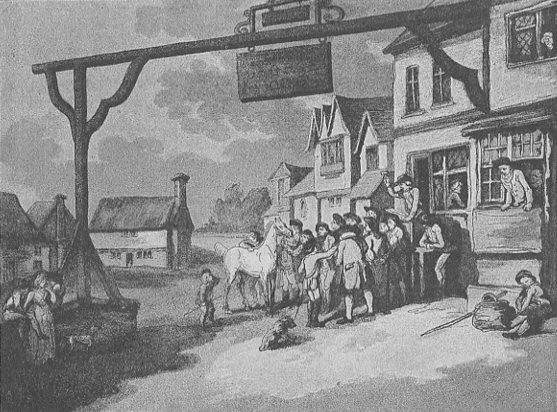
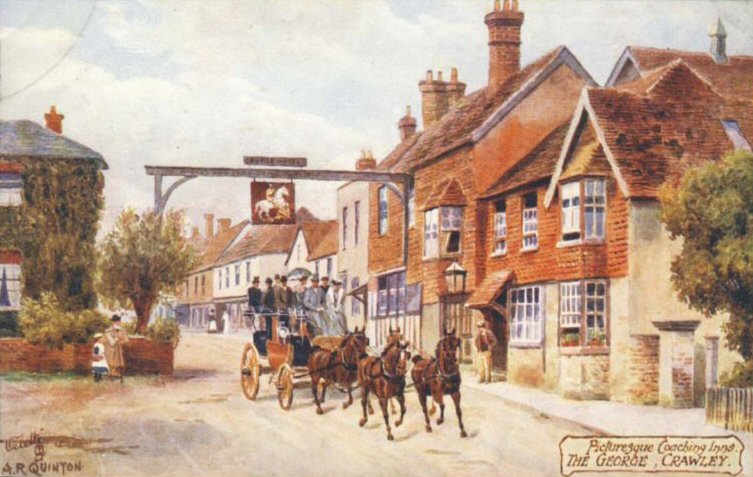
The George, probably originally a farmhouse, originated in the fifteenth century when a horse track was built between Reigate and Crawley. In 1580 it was included in the will of Richard Covert. In 1755 the road was widened and turnpiked and it became a busy coaching inn. The entrance on the northern end of the George led to a yard and stables at the rear. An extension was built over the entrance in about 1902. The annexe, in the middle of the High Street, was built in about 1800 and demolished in 1933, and in 1934 the hotel took over the premises of Holden's, the plumbers, next door.
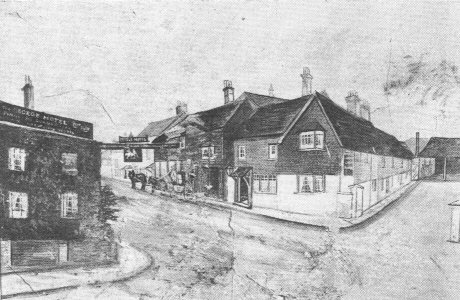
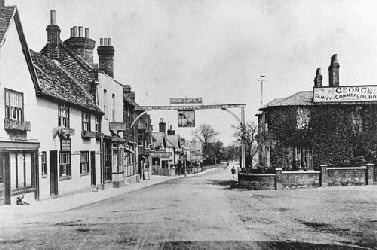
Goffs ManorGrade II Listed (1960)
Formerly the home of the actor Peter Vaughan.
Grapes, Pease Pottage
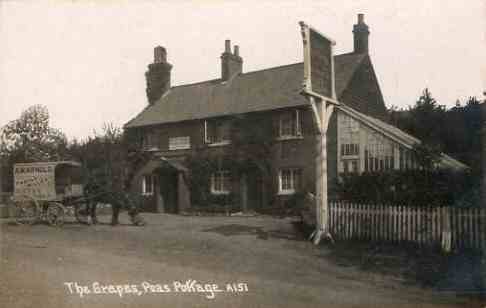
Originally a toll house. The Grapes closed at short notice at the end of 2008 by Hall and Woodhouse, and a change of use application made to Slaugham Parish Council. However, it was demolished in 2010.
Grasshopper, Tilgate
The Grasshopper opened on Wednesday 3rd February 1960 by Mann, Crossman & Paulin.
Crawley Observer, 5th February 1960The Greyhound, Radford RoadLocally Listed
Built in the 1930s.
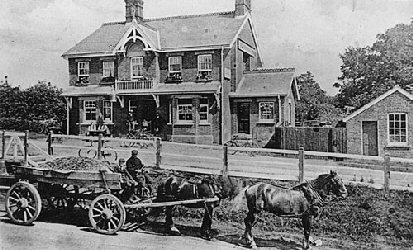
The original Half Moon stood well back from the road, but was replaced by a new building adjacent to the road in about 1890. The pub was refurbished and opened as a sports bar and renamed The New Moon on 28th August 2014.
Arthur Albert Smith (1938)Heathy Farm, Balcombe RoadGrade II Listed (1992)
Hillside Inn, Balcombe RoadGrade II Listed (1983)
An Inn called the The King's Head in the 19th century before becoming a private residence, then an antiques centre and kennels. It opened as the Hillside pub in the 1980s.
Henry Holder
Between 1869 and 1873 Henry Holder's brewery was either at Ockenden's Station Brewery or nearby on the corner of West Street and Oak Road.
Inn in the Park, Tilgate Park
Opened on 19th April 1968, the Inn in the Park was later renamed the Bluebird, which closed on 31st January 2009. Opened as a Smith & Western restaurant in March 2012.
The Jubilee Oak, 6 Grand Parade
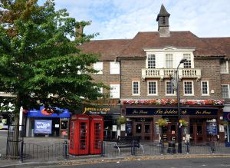
Kissingate Brewery, Maidenbower
The Kissingate Brewery began brewing in September 2009 in Maidenbower. The name derives from an iron kissing gate - which is a gate that swings in a u-shaped enclosure touching (kissing) each of two gateposts - which stood between Caffyn's Steam Mill and the cinder path leading to Maidenbower. The brewery has now moved to Lower Beeding.
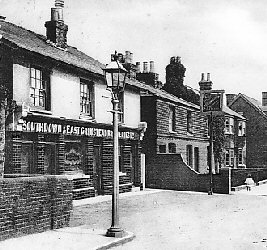
The Locomotive was a beerhouse in Three Bridges High Street (now Three Bridges Road) built after the Plough and Fox. It was rebuilt in an Edwardian Swiss-chalet style in about 1905. It was owned by the Southdown and East Grinstead Brewery which was sold to Tamplins of Brighton in 1924 which later became part of Watneys.
In 1977 it was refurbished, with the public and saloon bars being made into one large bar. A competition was held by the brewery for a new name for the pub, and it re-opened on Thursday 11th August 1977 as the Moonraker.
Crawley & District Observer, 12th August 1977; 19th August 1977.Maid of Sussex, Three Bridges
The Maid of Sussex opened on Tuesday 18th December 1956 by Courage & Co. It was completely refurbished and opened as Life Bar 1 in December 2007.
Crawley Observer, 20th December 1956; Courier, 21st December 1956; The Builder, 24th May 1957Mill House, Hyde Drive, Ifield
Closed at the end of 2013..
Moonraker, Three Bridges
See the Locomotive.
Morning Star Inn
Built in 1776 for Richard Hall, 34-36 High Street then became the Morning Star Inn.
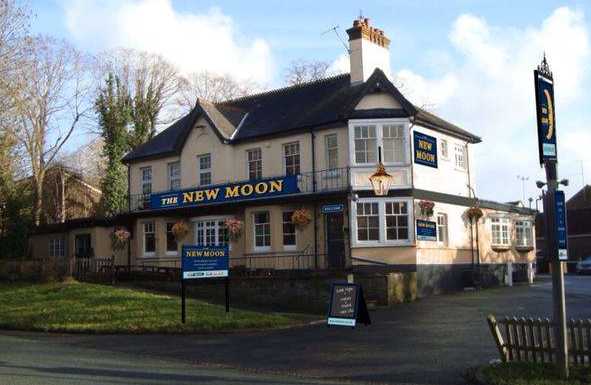
New Road Brewery - New Road (renamed later as 1 Post Office Road)
Run by George Ockenden & Son from about 1873 to 1907, when it was taken over by the Southdown and East Grinstead Brewery. See also the Station Brewery.
The Brewers of West Sussex, Peter Holtham, Sussex Industrial History No. 34
Sussex Breweries, Graham Holter, SB Publications (2001)
The Old Punch Bowl
A 15th century timber framed building, the Old Punch Bowl became a pub in 1994.
Pelham Buckle, Ifield
The Pelham Buckle opened on Tuesday 17th December 1957 by Mann, Crossman & Paulin.
Crawley Observer, 19th December 1957The Plough, IfieldGrade II Listed (1983)
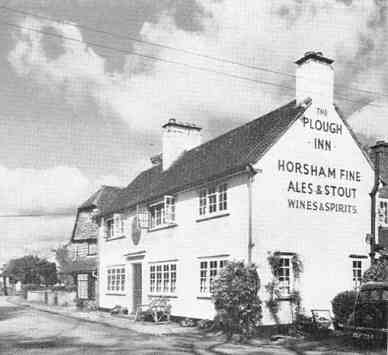
The original Plough Inn was built circa 1600 and is now Old Plough Cottage, the current inn was built in 1900.
The Plough Three Bridges
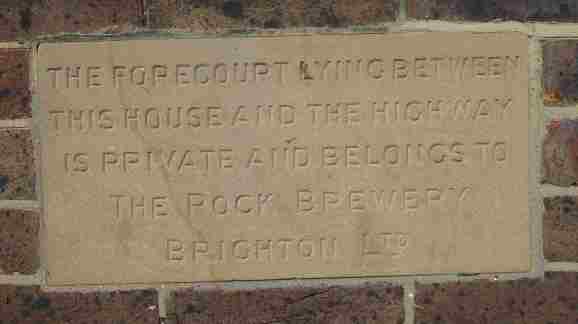 Rock Brewery stone panel
Rock Brewery stone panel
The cottages next to the Plough were demolished during the 1950s or 1960s to make way for a car park at the rear.
The Railway Hotel, 2-4 Brighton Road, Crawley
Opened as the Station Inn with the coming of the railway to Crawley, it later become the Railway Hotel. Stabling was provided at the rear which was also the base for a horse-drawn taxi service, and a small horse-drawn bus which ran to Handcross twice a day. There was also an Assembly Room at the rear, used for theatrical events, readings and other meetings, which was destroyed by fire in 1966. Election results for the Horsham constituency, of which Crawley was originally a part, were announced from the balcony, after being telegraphed to Crawley railway station. The pub was renamed The Rocket in 1969, later becoming the Firecracker and Firkin and then The Railway.
Henry Melling (1913); Frederick Merredew (1924); Alice E. Marshall (1938); J.H. Reen (1951); Friary Meux (1968)The Rat and Parrot, 91 High Street
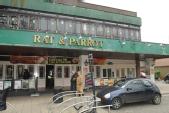
Opened in 1998 and closed in February 2011.
The Rising Sun, High Street, Crawley
The Rising Sun was a coaching inn near the North Toll Gate. It was the stopping place for the London to Brighton stagecoaches, but after they stopped running by 1846 the decline in business forced it's closure. The stables were taken over as the headquarters of Crawley Foxhounds. The building was divided into a two, North House School, a boarding school owned by Mr. J.O. Conlan, and a caf . It was demolished in 1980, and Midland House and Northgate House now occupy the site.
Rose and Crown
See the Crown Inn.
Royal Oak Inn - InnLocally Listed
Southdown and East Grinstead Breweries - Springfield Road; 1 Post Office Road
Formerly the New Road and Station Breweries run by the Ockendens.
The Brewers of West Sussex, Peter Holtham, Sussex Industrial History No. 34Henry Stantan
An Elizabethan brewer who was indicted for allegedly stealing nutmeg and cinnamon. He was not caught.
Sussex Breweries, Graham Holter, SB Publications (2001)Station Brewery - Springfield Road
Founded by Charles Ockenden about 1865, by 1882 it was owned by his nephew George Ockenden until 1907, when it was taken over by the Southdown and East Grinstead Brewery. Wine merchant Stanley Ball bought the Station Brewery site in 1921. See also the New Road Brewery.
The Brewers of West Sussex, Peter Holtham, Sussex Industrial History No. 34
Sussex Breweries, Graham Holter, SB Publications (2001)
The Sun, High Street, Crawley

Edward Dean obtained the licence of The Rising Sun and established The Sun, which was converted from a house opposite Woolborough Road, in 1864.
Sources & Further Reading
Wayfarer Denman's Crawley Revisited, Nadine Hygate (1993), p. 26
Crawley and District in Old Picture Postcards. Michael Goldsmith (European Library, 1978): Pls. 2 & 4
Crawley and District Courier, 17th May 1984
Crawley Observer, 9th February 1994
Swan - 1 Horsham RoadLocally Listed
Originally a beer shop, later known as the Westgreen Arms.
The White Hart, High Street, CrawleyGrade II Listed (1983)
The Old White Hart was originally located at the Ancient Priors in the High Street, but lost it's licence as a beerhouse in 1881. The current White Hart was built in 1770 and became a major staging post with stables. For a while it served as the town's first post office, James Swift, the landlord, was the first postmaster in 1810. Shortly after the post office moved next door. There was a large yard behind and stables alongside Morley's Yard - Morley's was the blacksmith's. The stables were later used as garages before being demolished in 1953 to make way for the Broadwalk.
John Alfred Wells (1913); William Skinner (1924); Arthur Sweetland (1938); Cecil F. Foster (1951); Harvey & Son (1968)White Knight, Pound Hill
The White Knight opened on Tuesday 1st October 1957 by Whitbread.
Crawley Observer, 4th Otober 1957; Architectural Review, Vol. 123 1958; The Architect and Building News, 14th October 1959White Lion, Lowfield Heath
The White Lion pub was next to the post office.
Windmill, Gossops Green
The Windmill opened on Monday 25th July 1960 by Mann, Crossman & Paulin.
Crawley Observer, 29th July 1960